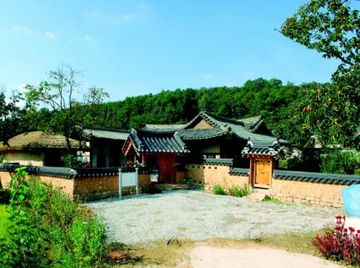예천 석문종택
| 예천 석문종택 Seongmun Head House, Yecheon |
|
 예천 석문종택, 국가문화유산포털, 문화재청. |
|
| 대표명칭 | 예천 석문종택 |
|---|---|
| 영문명칭 | Seongmun Head House, Yecheon |
| 한자 | 醴泉 石門宗宅 |
| 주소 | 경상북도 예천군 지보면 지포길 83(도장리) |
| 지정(등록) 종목 | 경상북도 문화재자료 제492호 |
| 지정(등록)일 | 2005년 9월 20일 |
| 분류 | 유적건조물/주거생활/주거건축/가옥 |
| 시대 | 조선시대 |
| 수량/면적 | 일원 |
| 웹사이트 | 예천 석문종택, 국가문화유산포털, 문화재청. |
|
|
|
해설문
국문
석문 종택은 조선 광해군 1년(1609) 석문 정영방(鄭榮邦,1577~1650)이 세우고 살았던 건물이다. 정영방은 조선 중기 문신으로 우복 정경세(愚伏 鄭經世) 문하에서 공부하였으며, 조선 선조 38년(1605) 진사에 입격하였으나 벼슬하지 않고 학문으로 일생을 보낸 인물이다.
종택의 전체 구성은 一자형 초가 대문채와 ㄇ자형 기와집 본채가 배치된 튼 口자형이다. 집 주위는 담장으로 둘렀고, 대문채에서 안마당으로 통하는 사주문(四柱文)* 외에 별도의 일각문(一角門)*을 두어 사랑채의 출입문으로 이용했다.
안채는 대청을 중심으로 안방과 부엌, 광이 직각으로 배치되었다. 사랑채는 대청을 중심으로 온돌방과 마루가 나란히 있고 직각으로 온돌방 3칸이 더 있다.
이와 같은 구성은 19세기 후반 이후의 주택에서 주로 볼 수 있는 유형으로서, 전통 한옥의 변천 과정을 이해하는데 중요한 자료이다.
- 사주문: 담장에 네 개의 기둥을 세우고 문짝을 달았던 문으로 주로 대문으로 사용
- 일각문: 담장에 의지해 두 개의 기둥을 세우고 그 사이에 문짝을 달았던 문으로 주로 협문으로 사용
영문
Seongmun Head House, Yecheon
This is the head house of the descendants of Jeong Yeong-bang (1577-1650, pen name: Seongmun), a civil official of the Joseon period (1392-1910). A head house is a residence passed down among the male successors of a family lineage. It was established in 1609 and was later rebuilt in 1920.
Jeong Yeong-bang was taught by the civil official and renowned neo-Confucian scholar Jeong Gyeong-se (1563-1633). In 1605, he passed the preliminary state examination but refused to serve any official posts. He devoted his entire life to his scholarly pursuits.
The house consists of a storehouse, a women’s quarters, and a men’s quarters. The women’s quarters and the men’s quarters are within the same building, with the women’s quarters on the left and the men’s quarters on the right. The women’s quarters consists of a wooden-floored hall at the center, an underfloor-heated room, a kitchen, and a storage room. The men’s quarters consists of a wooden-floored hall and four underfloor-heated rooms.
During the Joseon period, the Confucian ideology of separation of the sexes was strictly adhered to, and thus men and women had separate spaces. Although this house has these quarters in the same building, the use of exterior stone walls and gates creates separate entrances and courtyards. This kind of a design can been seen in houses from the late 19th century, as ideological propriety became influenced by the need for practical functionality. This house is thus an important resource in understanding changes in traditional Korean architecture.
영문 해설 내용
이 집은 조선시대의 문신인 정영방(1577-1650, 호: 석문) 가문의 종택이다. 종택이란 한 집안의 종가가 대대로 사는 집이다. 1609년에 세워졌으며, 1920년에 다시 지었다.
정영방은 조선시대의 문신이자 저명한 학자였던 정경세(1563-1633) 문하에서 공부하였으며, 1605년에 진사에 합격하였으나 관직을 거절하고 평생 학업에 종사하였다.
이 집은 헛간, 안채, 사랑채로 이루어져 있다. 안채와 사랑채가 한 건물에 배치되어 있는데, 본채 왼편은 안채이고 오른쪽이 사랑채이다. 안채는 대청을 중심으로 안방과 부엌, 광이 있다. 사랑채는 대청과 온돌방 네 개로 이루어져 있다.
조선시대에는 남녀유별의 성리학 이념에 따라 남성과 여성의 공간이 분리되어 있었다. 이 집은 남성과 여성의 공간이 비록 한 건물 안에 있지만, 별도의 돌담과 출입문을 두어 안마당이 있는 공간과 분리하였다. 이러한 구성은 19세기 후반 이후의 주택에서 주로 볼 수 있으며, 관념적인 예(禮)가 실용성의 영향을 받은 결과이다. 따라서 이 집은 전통 한옥의 변천 과정을 이해하는데 중요한 자료이다.